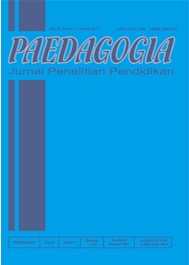Profile of Collaboration Skills in Learning Renewable Energy Materials
Abstract
Keywords
Full Text:
PDFReferences
Alfath, K. (2019). Teknik Pengolahan Hasil Asesmen: Teknik Pengolahan Dengan Menggunakan Pendekatan Acuan Norma (Pan) Dan Pendekatan Acuan Patokan (Pap). Al-Manar, 8(1), 1–28. https://doi.org/10.36668/jal.v8i1.105
Anggraeni Noviasari, N., & Widianingrum, R. (2023). Obstacle Analysis And Community Medicine Interprofessional Communication Solutions In Medical And Dental Students. Jurnal EduHealth, 14(3), 1400–1411. https://doi.org/10.54209/jurnaleduhealth.v14i3.2764
Anuruthwong, U. (2017). Education for the gifted/talented in Thailand. Cogent Education, 4(1). https://doi.org/10.1080/2331186X.2017.1332825
Asari, S. (2017). SHARING AND JUMPING TASK IN COLLABORATIVE Slamet Asari. 23(2), 184–188.
Barus, C. S. A. (2020). Efektivitas Model Pemebelajaran Icare Terhadap Keterampilan Berpikir Kritis Dan Keterampilan Kolaborasi Siswa Pada Materi Momentum Dan Impuls. Universitas Pendidikan Indonesia.
Curseu, P. L., Schruijer, S. G. L., & Fodor, O. C. (2017). Minority dissent and social acceptance in collaborative learning groups. Frontiers in Psychology, 8(MAR), 1–9. https://doi.org/10.3389/fpsyg.2017.00458
Fitriyani, D., Jalmo, T., & Yolida, B. (2019). Penggunaan Problem Based Learning untuk Meningkatkan Keterampilan Kolaborasi Dan Berpikir Tingkat Tinggi. Jurnal Bioterdidik, 7(2), 103–111.
Fuentes, S. Q. (2013). Fostering communication between students working collaboratively: Results from a practitioner action research study. Mathematics Teacher Education and Development, 15(1), 48–71. https://eric.ed.gov/?id=EJ1018616
Giel, L. I. S., Noordzij, G., Wijnia, L., Noordegraaf-, L., Denktaş, S., Giel, L. I. S., Noordzij, G., Wijnia, L., Noordegraaf-, L., & Group, F. (2020). When birds of the same feather fly together : the impact of achievement goal compatibility in collaborative learning. Educational Psychology. https://doi.org/10.1080/01443410.2020.1787352
Goke, R., & Violanti, M. (2024). Student-to-student communication: examining and extending our conceptualization and measurement of instructional dissent. Review of Communication. https://doi.org/10.1080/15358593.2024.2395278
Graesser, A. C., Fiore, S. M., Greiff, S., Andrews-Todd, J., Foltz, P. W., & Hesse, F. W. (2018). Advancing the Science of Collaborative Problem Solving. Psychological Science in the Public Interest, 19(2), 59–92. https://doi.org/10.1177/1529100618808244
Hashim, A. M., Aris, S. R. S., & Fook, C. Y. (2019). Promoting empathy using design thinking in project-based learning and as a classroom culture. Asian Journal of University Education, 15(3), 14–23.
Hernandez, V. (2018). The Relationship Between Leadership Qualities and Group Collaboration in Third-Grade Students. Education Undergraduate Research.
Johler, M. (2022). Collaboration and communication in blended learning environments. Frontiers in Education, 7, 1–14. https://doi.org/10.3389/feduc.2022.980445
Konrad, T., Wiek, A., & Barth, M. (2021). Learning to collaborate from diverse interactions in project-based sustainability courses. Sustainability (Switzerland), 13(17), 1–15. https://doi.org/10.3390/su13179884
Le, H., Janssen, J., & Wubbels, T. (2018). Collaborative learning practices: teacher and student perceived obstacles to effective student collaboration. Cambridge Journal of Education, 48(1), 103–122. https://doi.org/10.1080/0305764X.2016.1259389
Li, Y. (2019). LSU Scholarly Repository The Effects of Collaboration on Harmonization in College Group Piano (Issue May).
Mayordomo, R. M., & Javier, O. (2015). Work coordination and collaborative knowledge construction in a small group collaborative virtual task. Internet and Higher Education. https://doi.org/10.1016/j.iheduc.2015.02.003
Medina Dominguez, Maria Medina Rivilla, Antonio Medina, C. (2018). Empathetic and Collaborative Climate in the Classroom: Scenarios to Strengthen Coexistence in Schools. Violence Prevention and Safety Promotion in Higher Education. https://doi.org/10.4018/978-1-5225-2960-6.ch005
Meena, P. (2023). How do collaborative culture and capability improve sustainability ? Journal of Cleaner Production, May. https://doi.org/10.1016/j.jclepro.2021.125824
Nurmayasari, K. V., Pantiwati, Y., Wahyuni, S., Susetyarini, E. R., & Hindun, I. (2022). Studi Kemampuan Kolaborasi Siswa Dalam Pembuatan Herbarium Materi Klasifikasi Makhluk Hidup. Jurnal Education and Development, 10(2), 246–251.
Oikarinen, R. M., Oikarinen, J. K., Havu-Nuutinen, S., & Pöntinen, S. (2022). Students’ collaboration in technology-enhanced reciprocal peer tutoring as an approach towards learning mathematics. Education and Information Technologies, 27(6), 7519–7548. https://doi.org/10.1007/s10639-021-10799-3
Rahmawati, A., Fadiawati, N., & Diawati, C. (2019). Analisis Keterampilan Berkolaborasi Siswa SMA pada Pembelajarn Berbasis Proyek Daur Ulang Minyak Jelantah. Jurnal Pendidikan Dan Pembelajaran Kimia, 8(2), 431–443. https://jurnal.fkip.unila.ac.id/
Saenab, S., Yunus, S. R., & Virninda, A. N. (2017). PjBL untuk pengembangan keterampilan mahasiswa: sebuah kajian deskriptif tentang peran PjBL dalam melejitkan keterampilan komunikasi dan kolaborasi mahasiswa. Seminar Nasional Lembaga Penelitian UNM, 2(1), 45–50. https://ojs.unm.ac.id/semnaslemlit/article/viewFile/3739/2136
Saks, K., Hunt, P., Leijen, Ä., & Lepp, L. (2025). From Zero Collaboration to Teamwork: Forms of Teacher Collaboration and Factors That Support or Hinder It. Education Sciences, 15(1). https://doi.org/10.3390/educsci15010087
Sari, R., I., Niswah, C., Sofyan, F., A., & Sunardi. (2022). Hubungan Pembelajaran Collaborative Learning terhadap Sosial Emosional Anak Usia 4-5 Tahun di RA Muslimat NU 2 Palembang. ULIL ALBAB: Jurnal Ilmiah Multidisiplin, 1(5), 1105–1113.
Sheikhrezaei, K. (2019). Relating Individual Characteristics and Task Complexity to Performance Effectiveness in Individual and Collaborative Problem Solving [LSU Doctoral Dissertations]. https://doi.org/10.31390/gradschool_dissertations.5080
Simioni, A., Sgro, A., Pellino, G., Pasquali, S., Bath, M. F., Farina, V., Gavagna, L., & Pata, F. (2017). Response to the letter : Students ’ participation in collaborative research should be recognised. International Journal of Surgery, 44, 250–251. https://doi.org/10.1016/j.ijsu.2017.06.045
Suprapto, N., Rizki, I. A., & Cheng, T. H. (2024). Profile of Students’ Physics Critical Thinking Skills and Prospect Analysis of Project-Oriented Problem-Based Learning Model. Journal of Educational and Social Research, 14(3), 134–149. https://doi.org/10.36941/jesr-2024-0062
Thornhill-Miller, B., Camarda, A., Mercier, M., Burkhardt, J. M., Morisseau, T., Bourgeois-Bougrine, S., Vinchon, F., El Hayek, S., Augereau-Landais, M., Mourey, F., Feybesse, C., Sundquist, D., & Lubart, T. (2023). Creativity, Critical Thinking, Communication, and Collaboration: Assessment, Certification, and Promotion of 21st Century Skills for the Future of Work and Education. Journal of Intelligence, 11(3). https://doi.org/10.3390/jintelligence11030054
Trilling. (2009). Learning For Life In Our Times. Jossey Bass Willy.
Widyaningsih, E. E. (2017). Model Pembelajaran Team Assisted Individualization ( TAI ) Sebagai Upaya Optimalisasi Kontribusi Anggota Kelompok Dalam Praktikum IPA Materi Cahaya. Jurnal Materi Dan Pembelajaran Fisika, 7, 57–62.
Zambrano R., J., Kirschner, F., Sweller, J., & Kirschner, P. A. (2023). Effect of task-based group experience on collaborative learning: Exploring the transaction activities. British Journal of Educational Psychology, 93(4), 879–902. https://doi.org/10.1111/bjep.12603
Refbacks
- There are currently no refbacks.








